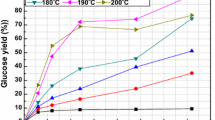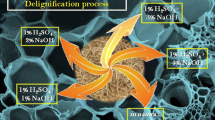Abstract
The enzymatic cocktail of cellulases is one of the most costly inputs affecting the economic viability of the biochemical route for biomass conversion into biofuels and other chemicals. Here, the influence of liquid hot water, dilute acid, alkali, and combined acid/alkali pretreatments on sugarcane bagasse (SCB) used for cellulase production was investigated by means of spectroscopic and imaging techniques. Chemical composition and structural characteristics, such as crystallinity (determined by X-ray diffraction), functional groups (Fourier transform infrared spectroscopy), and microstructure (scanning electron microscopy), were used to correlate SCB pretreatments with enzymatic biosynthesis by a strain of the filamentous fungus Aspergillus niger under solid-state fermentation. The combined acid/alkali pretreatment resulted in a SCB with higher cellulose content (86.7 %). However, the high crystallinity (74 %) of the resulting biomass was detrimental to microbial uptake and enzyme production. SCB pretreated with liquid hot water yielded the highest filter paper cellulase (FPase), carboxymethyl cellulase (CMCase), and xylanase activities (0.4, 14.9, and 26.1 U g−1, respectively). The results showed that a suitable pretreatment for SCB to be used as a substrate for cellulase production should avoid severe conditions in order to preserve amorphous cellulose and to enhance the physical properties that assist microbial access.





Similar content being viewed by others
References
CONAB (Companhia Nacional de Abastecimento) (2013) Acompanhamento de safra brasileira: cana-de-açúcar, terceiro levantamento, janeiro/2013 ed.
Leite, R. C. D., Leal, M. R. L. V., Cortez, L. A. B., Griffin, W. M., & Scandiffio, M. I. G. (2009). Can Brazil replace 5 % of the 2025 gasoline world demand with ethanol? Energy, 34, 655–661.
Macedo, I. C., Seabra, J. E. A., & Silva, J. E. A. R. (2008). Greenhouse gases emissions in the production, use of ethanol from sugarcane in Brazil: the 2005/2006 averages, a prediction for 2020. Biomass Bioenerg, 32, 582–595.
Seabra, J. E. A., Tao, L., Chum, H. L., & Macedo, I. C. (2010). A techno-economic evaluation of the effects of centralized cellulosic ethanol, co-products refinery options with sugarcane mill clustering. Biomass Bioenerg, 34, 1065–1078.
Alvira, P., Tomas-Pejo, E., Ballesteros, M., & Negro, M. J. (2010). Pretreatment technologies for an efficient bioethanol production process based on enzymatic hydrolysis: a review. Bioresource Technol, 101, 4851–4861.
Zhang, Y. H. P., Himmel, M. E., & Mielenz, J. R. (2006). Outlook for cellulase improvement: screening, selection strategies. Biotechnology Advances, 24, 452–481.
Rodríguez-Couto, S., & Sanromán, M. A. (2005). Application of solid-state fermentation to ligninolytic enzyme production. Biochemical Engineering Journal, 22, 211–219.
Mosier, N., Wyman, C., Dale, B., Elander, R., Lee, Y. Y., Holtzapple, M., & Ladisch, M. (2005). Features of promising technologies for pretreatment of lignocellulosic biomass. Bioresource Technol, 96, 673–686.
Yang, B., & Wyman, C. E. (2009). Dilute acid, autohydrolysis pretreatment. Methods. Molecular Biology, 581, 103–114.
Hernandez-Salas, J. M., Villa-Ramirez, M. S., Veloz-Rendon, J. S., Rivera-Hernandez, K. N., Gonzalez-Cesar, R. A., Plascencia-Espinosa, M. A., & Trejo-Estrada, S. R. (2009). Comparative hydrolysis, fermentation of sugarcane, agave bagasse. Bioresource Technol, 100, 1238–1245.
Kumar, R., Mago, G., Balan, V., & Wyman, C. E. (2009). Physical, chemical characterizations of corn stover, poplar solids resulting from leading pretreatment technologies. Bioresource Technol, 100, 3948–3962.
Zhang, Y. H. P., & Lynd, L. R. (2004). Toward an aggregated understanding of enzymatic hydrolysis of cellulose: noncomplexed cellulase systems. Biotechnology and Bioengineering, 88, 797–824.
Aiello, C., Ferrer, A., & Ledesma, A. (1996). Effect of alkaline treatments at various temperatures on cellulase, biomass production using submerged sugarcane bagasse fermentation with Trichoderma reesei QM 9414. Bioresource Technol, 57, 13–18.
Boussarsar, H., Roge, B., & Mathlouthi, M. (2009). Optimization of sugarcane bagasse conversion by hydrothermal treatment for the recovery of xylose. Bioresource Technol, 100, 6537–6542.
Cardona, C. A., Quintero, J. A., & Paz, I. C. (2010). Production of bioethanol from sugarcane bagasse: status and perspectives. Bioresource Technol, 101, 4754–4766.
Dias, M. O. S., Cunha, M. P., Jesus, C. D. F., Scandiffio, M. I. G., Rossell, C. E. V., Filho, M., & Bonomi, A. (2010). Simulation of ethanol production from sugarcane in Brazil: economic study of an autonomous distillery. Comput Aided Chem Eng, 28, 733–738.
Rocha, G. J. D., Martin, C., Soares, I. B., Maior, A. M. S., Baudel, H. M., & de Abreu, C. A. M. (2011). Dilute mixed-acid pretreatment of sugarcane bagasse for ethanol production. Biomass Bioenerg, 35, 663–670.
Singhania, R., Sukumaran, R. K., Patel, A. K., Larroche, C., & Pandey, A. (2010). Advancement, comparative profiles in the production technologies using solid-state, submerged fermentation for microbial cellulases. Enzyme Microb Tech, 46, 541–549.
Gusakov, A. V., Salanovich, T. N., Antonov, A. I., Ustinov, B. B., Okunev, O. N., Burlingame, R., Emalfarb, M., Baez, M., & Sinitsyn, A. P. (2007). Design of highly efficient cellulase mixtures for enzymatic hydrolysis of cellulose. Biotechnology and Bioengineering, 97, 1028–1038.
Sukumaran, R. K., Singhania, R. R., Mathew, G. M., & Pandey, A. (2009). Cellulase production using biomass feed stock, its application in lignocellulose saccharification for bio-ethanol production. Renew Energ, 34, 421–424.
Bhargav, S., Panda, B. P., Ali, M., & Javed, S. (2008). Solid-state fermentation: an overview. Chemical and Biochemical Engineering Quarterly, 22, 49–70.
Raghavarao, K. S. M. S., Ranganathan, T. V., & Karanth, N. G. (2003). Some engineering aspects of solid-state fermentation. Biochemical Engineering Journal, 13, 127–135.
Couri, S., & de Farias, A. X. (1995). Genetic manipulation of Aspergillus niger for increased synthesis of pectinolytic enzymes. Revista de Microbiologia, 26, 314–317.
Mandels, M., & Weber, J. (1969). Production of cellulases. Advances in Chemistry Series, 95, 391–414.
Van Soest, P. J. (1963). Use of detergents in the analysis of fibrous foods II A rapid method for the determination of fibre, lignin. Journal of the Association of Official Analytical Chemists, 46, 829–835.
Goering, H. K., & Van Soest, P. J. (1970). Forage fiber analyses, apparatus, reagents, procedures, some applications. Washington: USDA, Agricultural handbook.
AOAC. (1980). Official methods of analysis. Washington: AOAC.
Isogai, A., & Usuda, M. (1990). Crystallinity indexes of cellulosic materials. Sen'i Gakkaishi, 46, 324–329.
Ghose, T. K. (1987). Measurement of cellulase activities. Pure and Applied Chemistry, 59, 257–268.
Bailey, M. J., Biely, P., & Poutanen, K. (1992). Interlaboratory testing of methods for assay of xylanase activity. Journal of Biotechnology, 23, 257–270.
Miller, G. L. (1959). Use of dinitrosalicylic acid reagent for determination of reducing sugar. Analytical Chemistry, 31, 426–428.
Adsul, M. G., Ghule, J. E., Singh, R., Shaikh, H., Bastawde, K. B., Gokhale, D. V., & Varma, A. J. (2004). Polysaccharides from bagasse: applications in cellulase, xylanase production. Carbohyd Polym, 57, 67–72.
Singh, R., Varma, A. J., Laxman, R. S., & Rao, M. (2009). Hydrolysis of cellulose derived from steam exploded bagasse by Penicillium cellulases: comparison with commercial cellulase. Bioresource Technol, 100, 6679–6681.
Hendriks, A. T. W. M., & Zeeman, G. (2009). Pretreatments to enhance the digestibility of lignocellulosic biomass. Bioresource Technol, 100, 10–18.
Grethlein, H. E. (1985). The effect of pore size distribution on the rate of enzymatic hydrolysis of cellulosic substrates. Nature Biotechnology, 3, 155–160.
Zhang, J. A., Wang, X. S., Chu, D. Q., He, Y. Q., & Bao, J. (2011). Dry pretreatment of lignocellulose with extremely low steam, water usage for bioethanol production. Bioresource Technol, 102, 4480–4488.
Canilha, L., Santos, V. T. O., Rocha, G. J. M., Silva JB, A. E., Giulietti, M., Silva, S. S., Felipe, M. G. A., Ferraz, A., Milagres, A. M. F., & Carvalho, W. A. (2011). A study on the pretreatment of a sugarcane bagasse sample with dilute sulfuric acid. J Ind Microbiol Biot, 38, 1–9.
Zhao, H. B., Kwak, J. H., Zhang, Z. C., Brown, H. M., Arey, B. W., & Holladay, J. E. (2007). Studying cellulose fiber structure by SEM, XRD, NMR and acid hydrolysis. Carbohyd Polym, 68, 235–241.
Li, J. B., Henriksson, G., & Gellerstedt, G. (2007). Lignin depolymerization/repolymerization, its critical role for delignification of aspen wood by steam explosion. Bioresource Technol, 98, 3061–3068.
Donohoe, B. S., Decker, S. R., Tucker, M. P., Himmel, M. E., & Vinzant, T. B. (2008). Visualizing lignin coalescence, migration through maize cell walls following thermochemical pretreatment. Biotechnology and Bioengineering, 101, 913–925.
Sun, R. C., Sun, X. F., Fowler, P., & Tomkinson, J. (2002). Structural, physico-chemical characterization of lignins solubilized during alkaline peroxide treatment of barley straw. European Polymer Journal, 38, 1399–1407.
Xu, Z., Wang, Q., Jiang, Z., Yang, X., & Ji, Y. (2007). Enzymatic hydrolysis of pretreated soybean straw. Biomass Bioenerg, 31, 162–167.
Gabhane, J., Prince William, S. P. M., Vaidya, A. N., Mahapatra, K., & Chakrabarti, T. (2011). Influence of heating source on the efficacy of lignocellulosic pretreatment—a cellulosic ethanol perspective. Biomass Bioenerg, 35, 96–102.
Hansen, M. A. T., Kristensen, J. B., Felby, C., & Jorgensen, H. (2010). Pretreatment, enzymatic hydrolysis of wheat straw (Triticum aestivum L.)—the impact of lignin relocation, plant tissues on enzymatic accessibility. Bioresource Technol, 102, 2804–2811.
Klemm, D., Heublein, B., Fink, H. P., & Bohn, A. (2005). Cellulose: fascinating biopolymer, sustainable raw material. Angewandte Chemie, International Edition, 44, 3358–3393.
Bahng, M. K., Mukarakate, C., Robichaud, D. J., & Nimlos, M. R. (2009). Current technologies for analysis of biomass thermochemical processing: a review. Analytica Chimica Acta, 651, 117–138.
Kristensen, J. B., Thygesen, L. G., Felby, C., Jorgensen, H., & Elder, T. (2008). Cell-wall structural changes in wheat straw pretreated for bioethanol production. Biotechnology for Biofuels, 1, 5.
Schwanninger, M., Rodrigues, J. C., Pereira, H., & Hinterstoisser, B. (2004). Effects of short-time vibratory ball milling on the shape of FT-IR spectra of wood, cellulose. Vibrational Spectroscopy, 36, 23–40.
Hsu, T. C., Guo, G. L., Chen, W. H., & Hwang, W. S. (2010). Effect of dilute acid pretreatment of rice straw on structural properties, enzymatic hydrolysis. Bioresource Technol, 101, 4907–4913.
Himmelsbach, D. S., Khalili, S., & Akin, D. E. (2002). The use of FT-IR microspectroscopic mapping to study the effects of enzymatic retting of flax (Linum usitatissimum L) stems. J Sci Food Agr, 82, 685–696.
Lynd, L. R., Weimer, P. J., van Zyl, W. H., & Pretorius, I. S. (2002). Microbial cellulose utilization: Fundamentals, biotechnology. Microbiol Mol Biol R, 66, 506–577.
Acknowledgments
The authors express their gratitude to Embrapa, CNPq, and Finep (all from Brazil) for their financial support.
Author information
Authors and Affiliations
Corresponding authors
Rights and permissions
About this article
Cite this article
Rodríguez-Zúñiga, U.F., Neto, V.B., Couri, S. et al. Use of Spectroscopic and Imaging Techniques to Evaluate Pretreated Sugarcane Bagasse as a Substrate for Cellulase Production Under Solid-State Fermentation. Appl Biochem Biotechnol 172, 2348–2362 (2014). https://doi.org/10.1007/s12010-013-0678-0
Received:
Accepted:
Published:
Issue Date:
DOI: https://doi.org/10.1007/s12010-013-0678-0




